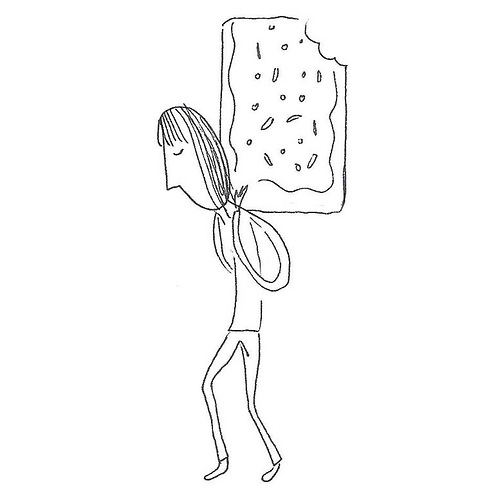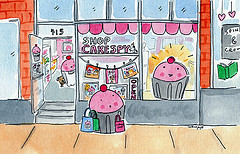Holey Grail: Why Do Doughnuts Have Holes?
 Wednesday, January 26, 2011
Wednesday, January 26, 2011  If you are a truly devoted doughnut lover, it's likely that this doughy dilemma has come up in your mind: why do doughnuts have holes?
If you are a truly devoted doughnut lover, it's likely that this doughy dilemma has come up in your mind: why do doughnuts have holes?
Turns out, there are a few tales out there. Let's discover them together, shall we?
 At least three versions of the story involve a Mr. Hanson Gregory, a seafarer who turned tall-tale-teller in his golden years. According to a 1938 article in The Tuscaloosa News,
At least three versions of the story involve a Mr. Hanson Gregory, a seafarer who turned tall-tale-teller in his golden years. According to a 1938 article in The Tuscaloosa News,
it remained for an old New England Sea captain, one Hanson Gregory, from Camden, Maine, to introduce the hole in the doughnut, as we know it today. As an old man he liked to tell his story many times--how as a boy he had been watching his mother frying doughnuts and had noticed that the centers always remained partially uncooked and doughy. 'Mother', he said, "leave a hole in the center." Laughingly, she obliged him and never went back to the old way. Her method was widely copied.
There is also an unlikely, but wholly (holey?) enjoyable, version of the story, also involving Gregory, which goes thusly (according to the Lewiston Evening Journal): "one legend is that he liked to munch fried cakes while steering his craft. One day, in 1847, the seas were rough and he needed both hands to control the rudder. So he slapped several cakes on the spoke of his wheel, making holes."
And third, there is a lighthearted variation on the lightened fried doughnut rounds which states that Gregory purposefully poked a hole in the doughnut to lighten it up "because he had already lost six men overboard due to the heaviness of the doughnuts".
 Of course, according to aforementioned Lewiston article, another New Englander, Henry Ellis, of Hyannis, MA, argued there was even a more outlandish story behind the doughnut hole: "An Indian's arrow aimed at a housewife pierced a round of fried cake". The article does not back this up with any evidence, but you know, this could just be further proof that it wasn't all making nice and Thanksgiving in the early US.
Of course, according to aforementioned Lewiston article, another New Englander, Henry Ellis, of Hyannis, MA, argued there was even a more outlandish story behind the doughnut hole: "An Indian's arrow aimed at a housewife pierced a round of fried cake". The article does not back this up with any evidence, but you know, this could just be further proof that it wasn't all making nice and Thanksgiving in the early US.
 Of course, Hanson Gregory's tales get even more street cred based on the fact that he's the only one commemorated as doughnut hole inventor who boasts a historical plaque: it's true. In Rockport, ME, you can find a plaque inscribed with the following: "In commemmoration. This is the birthplace of Captain Hanson Gregory, who first invented the hole in the doughnut in 1847. Erected by his friends, Nov. 2, 1947."
Of course, Hanson Gregory's tales get even more street cred based on the fact that he's the only one commemorated as doughnut hole inventor who boasts a historical plaque: it's true. In Rockport, ME, you can find a plaque inscribed with the following: "In commemmoration. This is the birthplace of Captain Hanson Gregory, who first invented the hole in the doughnut in 1847. Erected by his friends, Nov. 2, 1947."
And beyond that, the oldest article I could find on the subject points to Gregory as well (from the Washington Post, March 26, 1916), which I found here:
Old Salt” Doughnut Hole Inventor Tells Just How Discovery Was Made And Stomach of Earths Saved
Boston, March 25.—The man who invented the hole in the doughnut has been found. He is Capt. Hanson Gregory, at present an inmate in Sailor’s Snug Harbor, at Quincy, Mass. Doughnut cutters have made fortunes for men; millions eat doughnuts for breakfast and feel satisfied. Doctors do not assail the doughnut. And all of this owes its being to Capt. Gregory, who made the doughnut a safe, sane and hygienic food.
It’s a long story, mates; but as the 85-year-old chap relates it, it’s only too short. Outside the fact that Capt. Gregory is a bit hard of hearing, he’s as sound as new timber.
He’s a product of Maine; and so Maine can lay claim to the discoverer of the hole in the doughnut, along with the discoverer of new ways to evade the prohibition laws. But Capt. Gregory’s discovery is of real use in the world; millions have risen, and millions more shall rise up, and call him blessed.
‘Bout ‘47 Was the Date.
“It was way back—oh, I don’t know just what year—let me see—born in ‘31, shipped when I was 13—well, I guess it was about ‘47, when I was 16, that I was aboard ship and discovered the hole which was later to revolutionize the doughnut industry.
“I first shipped aboard the Isaac Achorn, three-masted schooner, Capt. Rhodes, in the lime trade.
Later I joined other crews and other captains, and it was on one of these cruises that I was mawing doughnuts.
“Now in them days we used to cut the doughnuts into diamond shapes, and also into long strips, bent in half, and then twisted. I don’t think we called them doughnuts then—they was just ‘fried cakes’ and ‘twisters.’
“Well, sir, they used to fry all right around the edges, but when you had the edges done the insides was all raw dough. And the twisters used to sop up all the grease just where they bent, and they were tough on the digestion.”
“Pretty d—d tough, too!” profanely agreed one of the dozen pipe-smoking fellows who were all eyes and ears, taking in their comrade’s interview by The Post reporter.
With a glance at the perfervid interrupter, the discoverer continued:
“Well, I says to myself, ‘Why wouldn’t a space inside solve the difficulty?’ I thought at first I’d take one of the strips (Col. 2—ed.) and roll it around, then I got an inspiration, a great inspiration.
“I took the cover off the ship’s tin pepper box, and—I cut into the middle of that doughnut the first hole ever seen by mortal eyes!”
“Were you pleased?”
“Was Columbus pleased? Well, sir, them doughnuts was the finest I ever tasted. No more indigestion—no more greasy sinkers—but just well-done, fried-through doughnuts.
“That cruise over, I went home to my old mother and father in Camden, Me., where I was born. My father, Hanson Gregory, sr., lived to be 93, and my mother lived to be 79. She was a pretty old lady then. I saw her making doughnuts in the kitchen—I can see her now, and as fine a woman as ever-lived, was my mother.
Taught Trick to Mother.
“I says to her: ‘Let me make some doughnuts for you.’ She says all right, so I made her one or two and then showed her how.
“She then made several panfuls and sent them down to Rockland, just outside Camden. Everybody was delighted and they never made doughnuts any other way except the way I showed my mother.
“Well, I never took out a patent on it; I don’t suppose any one can patent anything he discovers; I don’t suppose Peary could patent the north pole or Columbus patent America. But I thought I’d get out a doughnut cutter—but somebody got in ahead of me.
Hole “Cut Out,” His Joke.
“Of course a hole ain’t so much; but it’s the best part of the doughnut--you’d think so if you had ever tasted the doughnuts we used to eat in ‘31. Of course, lots of people joke about the hole in the doughnut. I’ve got a joke myself: Whenever anybody says to me: ‘Where’s the hole in the doughnut?’ I always answer: ‘It’s been cut out!’” and the old chap laughed loud and longat his little sally, while the rest joined in.
So there he sits—in the Snug Harbor by the sea. And whenever there’s doughnuts on the day’s fare, Capt. Gregory takes a personal pride trying to do what nobody’s succeeded in doing yet—in trying to find the hole in the doughnut. And whenever the old salts rally him about it, he always springs his little joke:
“The hole’s been cut out, I guess!” to the delight of the whole shipful.
While Gregory certainly has the flashiest connections to the doughnut hole, I'd just like to offer up a couple more bits of food for thought:
 Some say that the Pennsylvania Dutch were responsible for making the first holey doughnuts in the US, cutting the centers to ensure even frying and easier dunking.
Some say that the Pennsylvania Dutch were responsible for making the first holey doughnuts in the US, cutting the centers to ensure even frying and easier dunking.
Another theory that I personally have is that an explanation for the doughnut hole may be twofold: while the ease in even frying certainly makes sense, it also seems that the doughnut was rising in popularity in the US around the same time as the bagel, which were frequently sold on sticks on the Lower East Side of New York City. Could this easy mode of selling have perpetuated the ring around the doughnut?
 Oh, and finally, what of the dough from the middle? Interestingly, those little doughnut dots we love so much aren't necessarily cut from the same dough as the doughnut: "commercially made ring doughnuts are not made by cutting out the central portion of the cake but by dropping a ring of dough into hot oil from a specially shaped nozzle. However, soon after ring doughnuts became popular, doughnut sellers began to see the opportunity to market "holes" as if they were the portions cut out to make the ring."
Oh, and finally, what of the dough from the middle? Interestingly, those little doughnut dots we love so much aren't necessarily cut from the same dough as the doughnut: "commercially made ring doughnuts are not made by cutting out the central portion of the cake but by dropping a ring of dough into hot oil from a specially shaped nozzle. However, soon after ring doughnuts became popular, doughnut sellers began to see the opportunity to market "holes" as if they were the portions cut out to make the ring."
Seeking more holey grail? You might want to check out this article on Barry Popik, this one on Mr. Breakfast, or the fascinating Wikipedia entry. And of course, if you call yourself a doughnut devotee but don't own Donuts: An American Passion by John T. Edge, you really should remedy that immediately. It's a great book.

























Reader Comments (8)
Awesome!
The answer is that bagels and donuts have holes in them because of the way they are cooked – donuts being fried and bagels being boiled. Since they are so dense and full inside, the heat used during cooking wouldn't be able to reach all the way into the middle to cook the center if these yummy baked goods were simply disc-shaped with no hole!
Some people also say the hole once served another purpose, which was to help bakers display and sell their treats! Thanks to the hole, bagels and donuts could be strung together and hung up on display, or carried around on a stick for easy sale on-the-go!
Thanks